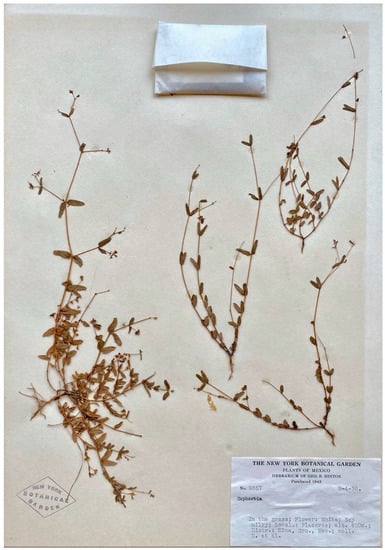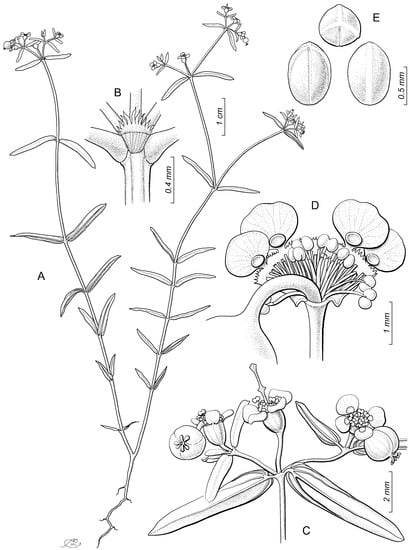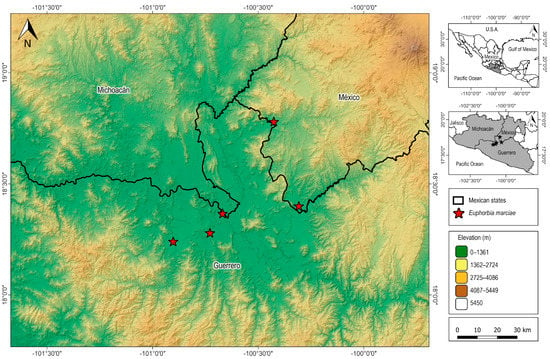Abstract
Euphorbia marciae, a new species from the lowlands of the Balsas Depression in southwestern Mexico, is described and illustrated. The species was first collected by the renowned botanist George B. Hinton during his explorations of the area in the 1930s. It is known from only five collections made in northwestern Guerrero and the extreme southwestern portion of the state of México, at elevations from 250 to 610 m. Vegetation of the area is tropical deciduous forest. Euphorbia marciae belongs to Euphorbia subg. Chamaesyce sect. Anisophyllum and resembles E. apatzingana, E. hyssopifolia, and E. nutans. However, it differs from these species in having smooth seeds. The seeds are nearly identical to those of E. pionosperma, an endemic species occurring in the Sierra Madre Occidental of eastern Sonora and western Chihuahua. However, the leaves of E. pionosperma are more conspicuously serrate and have larger stipules. In addition, Euphorbia pionosperma has smaller involucres and involucral appendages. Following IUCN Redlist criteria, E. marciae should be treated as Data Deficient (DD) until the species can be relocated and its populations field evaluated.
1. Introduction
George B. Hinton (1882–1943) was a pioneer plant collector and the first botanist to extensively explore the Balsas Depression of southwestern Mexico. His son James Hinton (1915–2006) often accompanied him on expeditions, and during the 1930s and early 1940s, they made more than 16,300 collections, primarily in the states of Guerrero, México, and Michoacán [1]. Their specimens are widely distributed in numerous herbaria, and at least 621 new species have been proposed on the basis of this material, including five species of Euphorbia L.: E. coalcomanensis (Croizat) V.W. Steinm., E. dressleri V.W. Steinm., E. hintonii L.C. Wheeler, E. linguiformis McVaugh, and E. succedeana L.C. Wheeler [2]. In the case of E. dressleri, it is known only from Hinton’s material, and subsequent relocation attempts have been futile [3]. Hinton’s collections continue to be invaluable for studies on Mexican plants, and the purpose of this article is to describe an additional new species of Euphorbia that was first collected by George B. Hinton in 1933, but whose specimens have remained unidentified or misidentified since its initial gathering.
2. Materials and Methods
During the study of Mexican Euphorbia, the herbarium collections of ARIZ, ENCB, F, K, MICH, NY, RSA, and USF (abbreviations according to Thiers [4]) were consulted, and a new Euphorbia species was encountered. Measurements and illustrations were made from herbarium specimens. The distribution map was generated using QGIS version 3.16.1 [5]. Latitude and longitude were estimated with Google Earth [6]. The conservation status was evaluated using IUCN Redlist criteria [7], and the extent of occurrence (EOO) and area of occupancy (AOO) were determined by the methods described by Bachman et al. [8]. The proposal of the new species follows the rules provided in the current International Code of Nomenclature for Algae, Fungi, and Plants [9].
3. Results
3.1. Taxonomic Treatment
Euphorbia marciae V.W. Steinm., sp. nov. TYPE: Mexico. Guerrero: distrito de Mina [municipio de Coyuca de Catalán], Placeres, [18.239° N, 100.903° W], 400 m, 4 September 1936, G.B. Hinton et al. 9357 (holotype: ENCB!; isotypes: A-00246271!, NY!, USF-205412!). Figure 1 and Figure 2.

Figure 1.
Euphorbia marciae. Hinton et al. 9357, isotype (NY).

Figure 2.
Euphorbia marciae. (A) Habit. (B) Node with stipules. (C) Dichasium. (D) Cyathium with the involucre opened. (E) Seeds, apical, dorsal, and ventral views. Illustrated by Alfonso Barbosa; based on Hinton et al. 9411 (MICH).
Similar to Euphorbia apatzingana, E. hyssopifolia, and E. nutans in being an erect to ascending herb with relatively large leaves, glabrous ovaries, and cyathia in weakly defined dichasia and subtended by bracts similar to the stem leaves but smaller; differing from these by having smooth, unsculptured seeds.
Similar to Euphorbia pionosperma in having smooth, unsculptured seeds; differing from this by having less conspicuously serrate leaves, smaller stipules, and larger involucres and involucral appendages.
Annual, erect to ascending, 11–22 cm tall, from a slender taproot; stems dichotomously branching, glabrous, terete, internodes of main stems 0.8–5.9 cm long; leaves opposite, stipules interpetiolar, 0.3–0.6 mm long, separate or united, deltoid or divided to nearly the base into 3–5 (9) subulate segments, glabrous, lacking punctiform reddish glands, petiole 0.3–0.8 mm long, glabrous, blade linear, lanceolate, or ovate, 0.6–1.8 cm long, 0.15–0.45 wide, apex acute to obtuse, base slightly asymmetrical, both sides cordate or 1 side cordate and the other side rounded to truncate, margin entire to serrulate especially towards the apex, glabrous, faintly 3-nerved from the base with the two lateral nerves often indistinct; cyathia in weakly defined dichasia at the tips of the branches, bracts like the stem leaves but smaller, peduncle 0.3–1.6 mm long (to 6.5 mm at the first flowering node), involucre cylindrical to broadly obconical, glabrous, 1.2–1.4 mm long, 0.9–1.2 mm in diameter, lobes deltoid or laciniate into 4–6 subulate segments, 0.2 mm long, ciliate-pilose, sinus not evident, glands 4, concave, circular to transversely oblong, 0.1–0.2 mm long, 0.15–3 mm wide, appendages present, oblong, transversely reniform, to flabellate, to almost orbicular, 0.5–1 mm long, 1.1–1.4 mm wide, white, glabrous, unlobed but sometimes shallowly undulate, entire; staminate flowers approx. 40–50, bracteoles few, densely pilose distally; pistillate flower on a glabrous gynophore exserted from the involucre 0.6–1.7 mm, ovary ovoid to depressed globose, 3-lobed, glabrous, styles 3, 0.6–0.8 mm long, bifid 1/2–2/3 their length, narrowly cylindrical, not swollen at the apex; capsule oblate-ovoid, 1.6–1.8 mm long, 2–2.4 mm wide, glabrous, columella 1.6–1.9 mm long; seeds obloid, 1.2–1.4 mm long, 0.7–0.9 mm wide, faintly 3-angled in cross section with a low indistinct dorsal keel, apex and base rounded, brown to blackish at maturity, smooth, with a conspicuous mucilaginous coat, without a caruncle.
3.2. Additional Specimens Examined (Paratypes)
MEXICO. Estado de México: distrito de Temascaltepec [municipio de Tejupilco], Bejucos, [18.779° N, 100.426° W], 610 m, 19 September 1933, G.B. Hinton 4775 (ARIZ, F, GH, K, NY); municipio de Tlatlaya, San Antonio, [18.398° N, 100.308° W, 390 m], 19–20 July 1954, E. Matuda et al. 31210 (MEXU). Guerrero: distrito de Mina [municipio de Coyuca de Catalán], Manchón/Parotas, Filo, [18.278° N, 100.728° W, 284 m], 31 August 1936, G.B. Hinton et al. 9411 (F, K, MICH, NY-2 sheets, USF); carretera Zitácuaro-Huetamo, límites entre Gro. y Mich., [18.365° N, 100.668° W, 250 m], 7 September 1981, A. Díaz O. & A.A. Vargas 336 (MEXU).
3.3. Distribution, Habitat and Phenology
Euphorbia marciae is endemic to the lowlands of the Balsas Depression of southern Mexico (Figure 3). It is known from northwestern Guerrero and the extreme southwestern portion of the state of México, at elevations from 250 to 610 m. It likely also occurs in southeastern Michoacán, because one collection was made just across the border in Guerrero, and the extrapolated extent of occurrence (EOO) includes a portion of Michoacán. The vegetation of this region is dominated by tropical deciduous forest, following Rzedowski [10], and there is a pronounced dry season with little rain from November to May. The Hinton collections describe the habitat as “llano” or “in the grass,” almost certainly referring to the grassy openings that often occur naturally on rocky substrates within the tropical deciduous forest. The Diaz & Vargas specimen states that plants were found in pastures, and the Matuda et al. sheet says a humid hillside with low scrub. Flowering and fruiting overlap, and reproductive plants have been gathered from July to September, but certainly extend into at least November.

Figure 3.
Distribution of Euphorbia marciae.
3.4. Conservation Status
I am aware of only five collections of Euphorbia marciae, the most recent of which was made more than 40 years ago. None of these are from protected areas. The extent of occurrence (EOO) is 1470 km2, and the area of occupancy (AOO) is 20 km2. There are no available data about population size or potential reductions. The only specimen that provides information about abundance describes the species as scarce (Díaz & Vargas 336). The tropical deciduous forest of the Balsas region is generally considered endangered [11], and as a result, we can infer that overall habitat loss has occurred and is likely to continue. However, many related species of Euphorbia subg. Chamaesyce sect. Anisophyllum are favored by disturbance, and at least one collection of E. marciae was made in a pasture (Díaz & Vargas 336). At present, it should be treated as Data Deficient (DD) until the species can be rediscovered and its populations field evaluated. If the plants are indeed as rare as the few collections suggest, and not favored by disturbance, its reduced distribution would warrant assessment as Endangered under criteria B1 and B2 (following [7]).
3.5. Etymology
Euphorbia marciae is named after my mother, Marcia Marie Steinmann, née Bradley (1938–2018), who not only gave me my life, but always offered unconditional support and encouragement, especially with regard to my interest in biology.
4. Discussion
Euphorbia is characterized by a pseudanthial inflorescence, termed a cyathium, in which the flowers lack a perianth and are reduced to a single anther or ovary. It contains more than 2000 species and has a near-cosmopolitan distribution [12]. Euphorbia is the second most diverse genus in Mexico, and Villaseñor [13] reports 245 species from the country. The genus occurs in nearly all vegetation types from sea level to approximately 3500 m. Although there is no account of the number of species in the Balsas Depression, I estimate that at least 85 species are present. Several of these are endemic to the region, such as Euphorbia arteagae W.R. Buck & Huft, E. calcicola Fernald, E. grammata McVaugh, E. hintonii, E. infernidialis V.W. Steinm., E. linguiformis, E. lottiae V.W. Steinm., E. muscicola Fernald, E. rzedowskii McVaugh, and E. vestita Boiss., in addition to the herein described species.
Based on the dichotomous branching and opposite leaves with interpetiolar stipules and blades asymmetrical at the base, Euphorbia marciae belongs to Euphorbia subg. Chamaesyce Raf. section Anisophyllum Roeper, as defined by Yang et al. [14]. Seeds are often necessary to distinguish taxa within the section, and those of E. marciae serve to separate it from similar species. Vegetatively, E. marciae resembles E. apatzingana McVaugh, E. hyssopifolia L., and E. nutans Lag. It shares with these species an erect to ascending habit, relatively large leaves, glabrous ovaries, and cyathia in weakly defined dichasia, subtended by bracts that are like the stem leaves but smaller. These species also occur in the Balsas Depression of Guerrero (E. apatzingana, E. hyssopifolia, E. nutans) and the state of México (E. hyssopifolia, E. nutans). In fact, one specimen of E. marciae was initially determined as E. hyssopifolia (Díaz & Vargas 336). In contrast to the smooth, unsculptured seeds of E. marciae, those of E. nutans are conspicuously wrinkled, and those of E. hyssopifolia have two or three conspicuous transverse ridges. Euphorbia apatzingana has seeds with one or two ill-defined longitudinal rows of three or four shallow concave depressions that are separated by longitudinal and transverse ridges.
Whereas the smooth seeds of Euphorbia marciae distinguish the species from the above taxa, they are nearly identical to those of E. pionosperma V.W. Steinm. & Felger. The latter is endemic to pine-oak forests in the Sierra Madre Occidental of eastern Sonora and western Chihuahua. Although habit is also similar, and both species are glabrous annuals, the leaves of E. pionosperma are more conspicuously serrate and have larger stipules (0.4–1.7 mm long vs. 0.3–0.6 mm long). In addition, Euphorbia pionosperma has smaller involucres (0.8–1.2 × 0.5–0.8 mm vs. 1.2–1.4 × 0.9–1.2 mm) and smaller involucral appendages (nearly absent to 0.4 × 0.6 mm vs. 0.5–1 × 1.1–1.4 mm).
Specimens of Hinton et al. 9411 are labelled either as “Manchón” or “Parotas, Filo.” These names refer to the same locality, a small town now known as Las Parotas and located approximately 5 km south-southwest of Coyuca de Catalán, Guerrero.
Funding
This research received no external funding.
Institutional Review Board Statement
Not applicable.
Informed Consent Statement
Not applicable.
Data Availability Statement
Not applicable.
Acknowledgments
I thank the curators and staffs of the herbaria ARIZ, ENCB, F, K, MICH, NY and RSA for allowing access to their collections or making their collections available online; the herbarium of the California Botanical Garden (RSA) for assisting with specimen loans and use of their facilities; Alfonso Barbosa for preparing the line drawing, Figure 2; and Martín Abraham Ornelas for elaborating the map, Figure 3.
Conflicts of Interest
The author declares no conflict of interest.
References
- Hinton, J.; Rzedowski, J.; George, B. Hinton, collector of plants in southwestern Mexico. J. Arnold Arbor. 1972, 53, 141–181. [Google Scholar] [CrossRef]
- Hinton, G.S.; Villaseñor, J.L.; Ortiz, E. The Hintons’ legacy to the knowledge of the flora of Mexico. Bot. Sci. 2019, 97, 447–538. [Google Scholar] [CrossRef]
- Olson, M.E.; Lomeli, S.J.A.; Cacho, N.I. Extinction threat in the Pedilanthus clade (Euphorbia, Euphorbiaceae), with special reference to the recently rediscovered E. conzattii (E. pulchellus). Amer. J. Bot. 2005, 92, 634–641. [Google Scholar] [CrossRef] [PubMed] [Green Version]
- Thiers, B. New York Botanical Garden’s Virtual Herbarium. Index Herbariorum: A Global Directory of Public Herbaria and Associated Staff. 2022. Available online: http://sweetgum.nybg.org/science/ih/ (accessed on 30 April 2022).
- QGIS, A Source Geographic Information System. Available online: https://www.qgis.org/en/site/ (accessed on 16 May 2022).
- Google Earth. Available online: https://earth.google.com (accessed on 16 May 2022).
- IUCN (International Union for Conservation of Nature). Guidelines for Using the IUCN Red List Categories and Criteria. Version 15; Prepared by the Standards and Petitions Subcommittee of the IUCN Species Survival Commission; IUCN: Gland, Switzerland, 2022; Available online: http://www.iucnredlist.org/documents/RedListGuidelines.pdf (accessed on 22 January 2022).
- Bachman, S.; Moat, J.; Hill, A.W.; de la Torre, J.; Scott, B. Supporting Red List threat assessments with GeoCAT: Geospatial conservation assessment tool. In E-Infrastructures for Data Publishing in Biodiversity Science; Smith, V., Penev, L., Eds.; Pensoft: Sofia, Bulgaria, 2011; Volume 150, pp. 117–126. [Google Scholar] [CrossRef]
- Turland, N.J.; Wiersema, J.H.; Barrie, F.R.; Greuter, W.; Hawksworth, D.L.; Herendeen, P.S.; Knapp, S.; Kusber, W.-H.; Li, D.-Z.; Marhold, K.; et al. International Code of Nomenclature for Algae, Fungi, and Plants (Shenzhen Code) Adopted by the Nineteenth International Botanical Congress Shenzhen, China, July 2017; Koeltz Botanical Books: Glashütten, Germany, 2018; Volume 159. [Google Scholar]
- Rzedowski, J. La vegetación de México; Limusa: Ciudad de México, México, 1978; pp. 1–505. [Google Scholar]
- Dinerstein, E.; Olson, B.M.; Graham, D.J. A Conservation Assessment of the Terrestrial Ecoregions of Latin America and the Caribbean; World Bank: Washington, DC, USA, 1995; ISBN 978-0821332955. [Google Scholar]
- Horn, J.W.; van Ee, B.W.; Morawetz, J.J.; Riina, R.; Steinmann, V.W.; Berry, P.E.; Wurdack, K.J. Phylogenetics and the evolution of major structural characters in the giant genus Euphorbia L. (Euphorbiaceae). Mol. Phylogenet. Evol. 2012, 63, 305–326. [Google Scholar] [CrossRef] [PubMed]
- Villaseñor, J.L. Checklist of the native vascular plants of Mexico. Rev. Mex. Biodivers. 2016, 87, 559–902. [Google Scholar] [CrossRef] [Green Version]
- Yang, Y.; Riina, R.; Morawetz, J.J.; Haevermans, T.; Aubriot, X.; Berry, P.E. Molecular phylogenetics and classification of Euphorbia subgenus Chamaesyce (Euphorbiaceae). Taxon 2012, 61, 764–789. [Google Scholar] [CrossRef] [Green Version]
Publisher’s Note: MDPI stays neutral with regard to jurisdictional claims in published maps and institutional affiliations. |
© 2022 by the author. Licensee MDPI, Basel, Switzerland. This article is an open access article distributed under the terms and conditions of the Creative Commons Attribution (CC BY) license (https://creativecommons.org/licenses/by/4.0/).